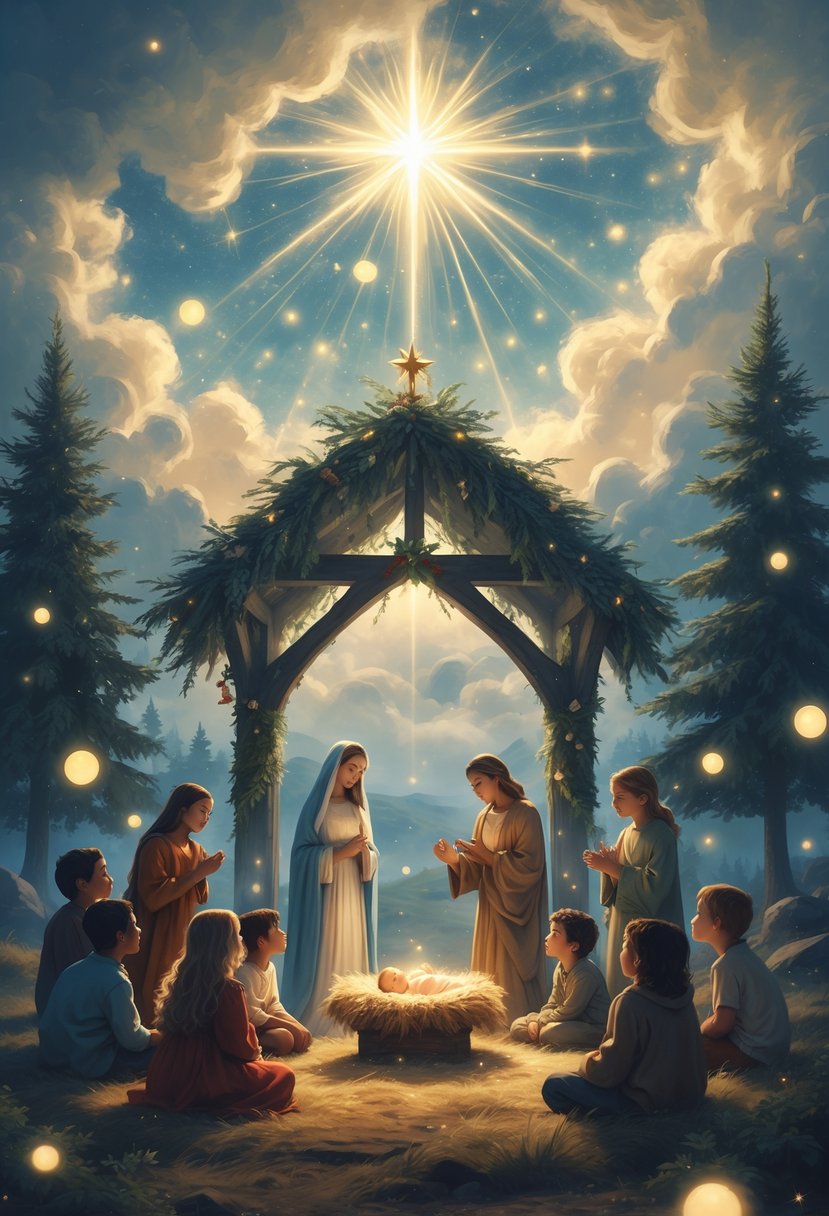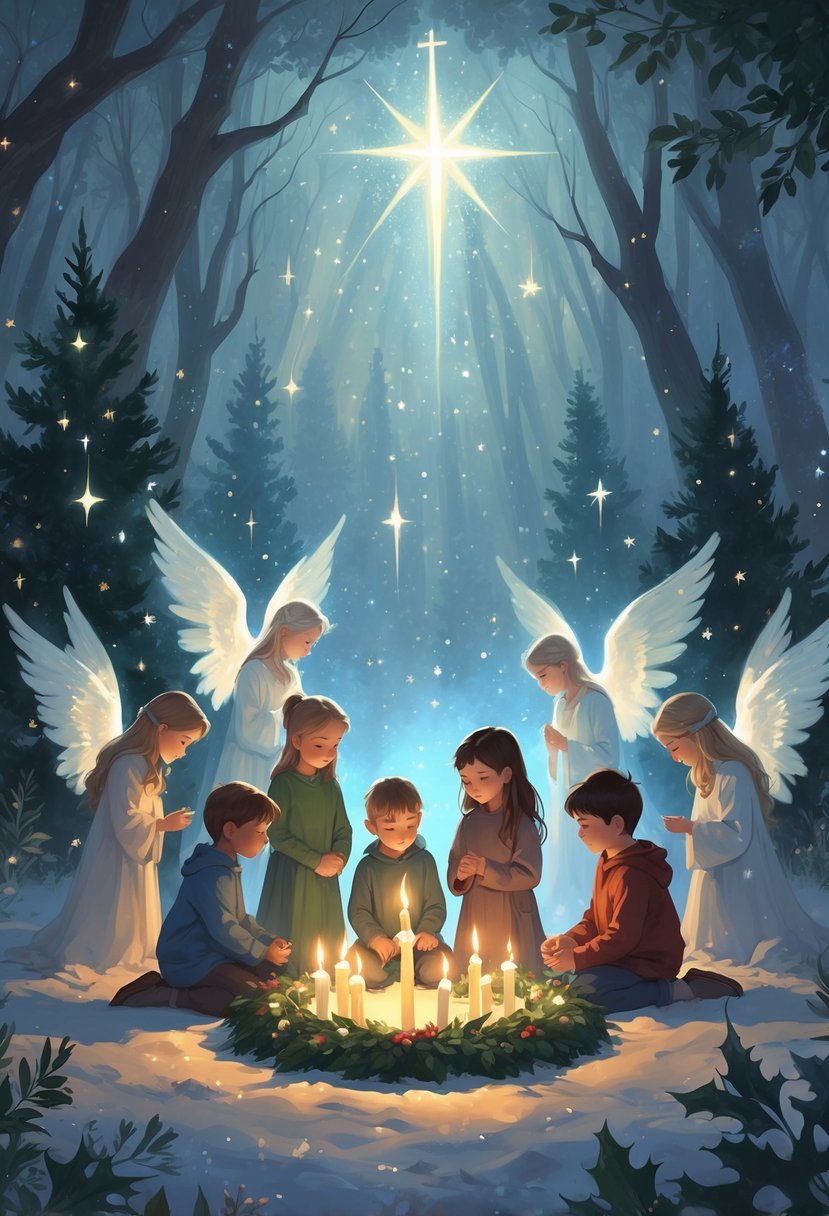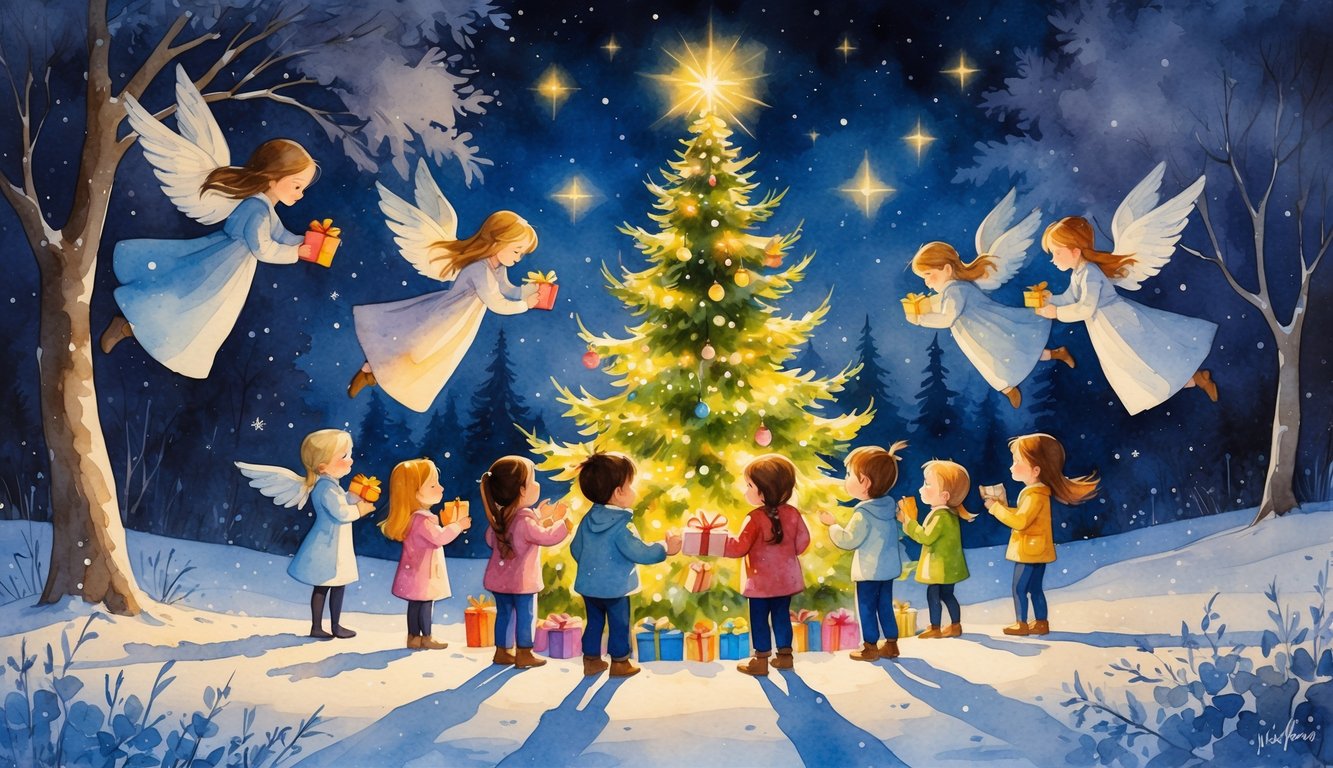Christmas brings excitement and wonder to children. But let’s be honest—the season’s true meaning can vanish under piles of gift lists and endless holiday prep.
Between decorating, shopping, and all those activities, families often struggle to help their kids understand why we really celebrate Jesus’s birth.
Teaching children the true meaning of Christmas takes a little intention and some creative activities. You want to connect the story of Jesus to their everyday lives, but still keep the joy and magic alive.
You can create traditions that help your kids grasp love, generosity, and service without overwhelming them. No need to take away the fun they already love.
From creative nativity activities to hands-on service projects, there are ways to weave faith into your holiday. It’s all about balancing what your family enjoys with little moments that help your kids connect Christmas to God’s love.
Explaining the True Meaning of Christmas

The foundation of teaching kids the true meaning of Christmas starts with sharing the actual Christmas story. Help them understand why Jesus’s birth matters.
These conversations help kids connect the holiday traditions they see around them with the deeper spiritual significance of Christmas.
Sharing the Christmas Story
You can make the Christmas story come alive for your kids through simple storytelling. Start by reading Bible stories or children’s books about Mary, Joseph, and the journey to Bethlehem.
Key elements to include:
- Mary receiving the angel’s message
- The journey to Bethlehem
- No room at the inn
- Jesus born in a stable
- The shepherds and wise men visiting
Try using visual aids like nativity scenes or picture books to help younger kids follow along. You might even act out parts of the story together—let your kids play different characters.
Make it interactive. Ask questions like, “How do you think Mary felt when the angel appeared?” This helps kids connect emotionally with the story.
Discussing the Birth of Jesus
Help your children understand why Jesus’s birth was special. Explain that Christians believe Jesus was God’s son who came to earth as a human baby.
Simple concepts to share:
- Jesus came to show God’s love for people
- His birth fulfilled promises God made long ago
- Jesus grew up to teach people about God’s love
- Christmas celebrates this special gift from God
You can connect this to your family’s daily life by talking about how Jesus’s teachings about love, kindness, and helping others apply today.
Use examples they understand. Say that just as parents love their children, God loves all people and sent Jesus to show that love.
Making the Christmas Story Engaging for Children

Bringing the Christmas story to life takes hands-on activities and creative storytelling. Multi-sensory activities like acting out the story and creating crafts make the nativity memorable and meaningful for young minds.
Interactive Storytelling
Turn the birth of Jesus into an immersive experience by letting kids act out different roles. Assign parts like Mary, Joseph, shepherds, and wise men while you narrate.
Character Engagement Ideas:
- Let kids wear simple costumes or props
- Have them make animal sounds for the stable
- Encourage questions during the story
- Use different voices for each character
Interview an expecting mother so kids can relate to Mary’s journey. This real-world connection makes the story more relatable.
Create a story map where kids can trace Mary and Joseph’s journey. Use pictures or drawings to show each part of the nativity as you tell it.
Using Nativity Scene Activities
Build a nativity scene together as a family project. Kids can help create figures from clay, cardboard, or whatever you have handy.
Hands-on Nativity Ideas:
- Make figures from playdough or modeling clay
- Use blocks to build the stable
- Create paper angels and stars
- Add straw or small stones
Set up the nativity scene gradually through December. Start with Mary and Joseph, add baby Jesus on Christmas Eve, and bring in the wise men on Epiphany.
Let kids rearrange and play with the figures. When they retell the story in their own words, it really sticks.
Advent Traditions for Deeper Meaning

Advent traditions help children see Christmas as more than just gifts. Focusing on waiting, hope, and Jesus’s birth story can make the season more meaningful.
Daily advent calendar activities and weekly candle lighting create special moments that connect your family to the true meaning of Christmas.
Advent Calendar Activities
Creating meaningful advent activities helps your children look forward to Christmas while learning about Jesus’s story. Make a simple calendar with envelopes filled with daily activities like reading Bible verses, singing songs, or delivering cookies to neighbors.
Daily Activity Ideas:
- Add one piece to the nativity scene each day
- Read a Christmas story from the Bible
- Make cards for elderly neighbors
- Practice acts of kindness
- Learn the names of Jesus
Progressive nativity building works well with young kids. Start with an empty stable and add Mary, Joseph, animals, and shepherds throughout December.
You can also use leftover Halloween candy for a countdown calendar. Let the kids pick a favorite each day and talk about the advent story as you go.
Lighting Advent Candles
Weekly advent candle lighting is a peaceful tradition that centers your family on waiting for Jesus. The traditional advent wreath uses four candles, one for each Sunday before Christmas—hope, peace, joy, and love.
Advent Wreath Setup:
- Three purple candles (hope, peace, love)
- One pink candle (joy, third Sunday)
- White Christ candle (Christmas Eve)
Each week, light the candles and read Scripture about Jesus’s coming. Sing “O Come, O Come Emmanuel” or another carol that tells the story.
The growing light each week shows how Jesus brings light to the world’s darkness.
Hands-On Ways to Experience Christmas

Physical activities help kids connect with Christmas through their senses and creativity. Creating nativity scenes and reading stories together build lasting memories while teaching the Christmas message.
Crafting a Nativity Scene
Building your own nativity scene makes the Christmas story tangible. Start with simple materials like cardboard boxes, clay, or wooden figures.
Easy Materials:
- Cardboard and construction paper
- Modeling clay or playdough
- Small wooden blocks
- Fabric scraps for clothing
- Twigs and moss
Let your kids help design each figure. They can shape Mary, Joseph, baby Jesus, the shepherds, and wise men.
The stable can be a cardboard box turned on its side. Add hay or yellow paper strips for the manger.
Interactive Elements:
- Moveable figures for kids to arrange
- Story cards explaining each character
- LED tea lights for safe lighting
Kids remember the details better when they’ve shaped each element themselves.
Reading Christmas-Themed Books
Christmas books make the nativity story come alive with colorful illustrations and simple language. Pick books that focus on Jesus’s birth, not just holiday traditions.
Look for stories that explain why Jesus came to earth. Picture books are great for little ones; chapter books work for older kids.
Reading Activities:
- Act out scenes from the book
- Draw favorite characters
- Discuss what each character might have felt
- Create new endings to familiar stories
Set aside cozy reading time during December. Add blankets, hot chocolate, and soft lighting.
Encourage your kids to retell the Christmas story in their own words after reading. It helps them really get the message.
Serving Others as a Reflection of Christmas
Teaching kids to serve others during Christmas helps them see that giving and compassion are at the heart of the season. Simple acts of kindness and small charity projects show kids how Christmas is about more than just receiving gifts.
Acts of Kindness as a Family
Start with gestures your kids can understand and join in. Taking candy canes to your child’s preschool class brings joy to others and teaches the happiness of giving.
Visit elderly neighbors or people at senior living facilities. Your kids can sing carols or just chat with older adults who might feel lonely during the holidays.
Bake cookies together and deliver them to neighbors. It strengthens community bonds and shows your kids how small acts can create big smiles.
Leave thank-you gifts for service workers in your community. A simple card and a small gift card for your mail carrier or grocery cashier teaches kids to recognize those who help others all year.
Make family video calls to distant relatives a tradition. Let your kids perform songs or share artwork and brighten someone’s day, even if you can’t visit in person.
Charity Projects for Kids
Organize donation drives that get your kids involved right from the start. Let your kids fill bags with canned goods for local food banks and turn it into a pantry scavenger hunt.
Collect winter clothing to donate to homeless shelters. Have your children help sort through outgrown coats and warm clothes, and talk about how these items will help others stay warm.
Create hygiene kits for local shelters by gathering things like soap, toothbrushes, and shampoo. Kids can help pack these supplies into bags and learn about basic needs many people go without.
Adopt a family through local charities during Christmas. Let your kids help pick out toys and gifts for other children, encouraging them to think about what might make someone else happy.
Set up a neighborhood toy drive and invite your children to encourage friends to donate gently used toys. This project shows them that their leadership can inspire others to give back.
Focusing on Gratitude and Generosity

Teaching kids to appreciate what they have and feel joy in giving to others is at the heart of Christmas. These values help children see that the holiday celebrates love, kindness, and community—not just gifts.
Encouraging Thankfulness
Start December mornings by asking your child to name three things they’re grateful for. This little ritual nudges their attention away from wish lists and toward what they already have.
Create a family gratitude jar and let everyone drop in notes about happy moments throughout the month. On Christmas Eve, read them aloud together and remember the year’s blessings.
Teaching gratitude in early childhood helps kids slow down and notice simple things they might take for granted. Try using bedtime stories that highlight thankfulness.
Daily gratitude activities:
- Morning thankfulness sharing
- Gratitude journaling with drawings
- Thank-you note writing for family
- Appreciating nature walks
Model grateful behavior by saying thanks for everyday things—like family meals or cozy evenings. Kids pay more attention to what you do than what you say.
The Joy of Giving vs. Receiving
Let your kids see firsthand how giving brings more joy than receiving. Take them shopping to pick out toys for children’s hospitals or food for local food banks.
Encourage your kids to choose one of their own toys to donate to children who have less. It’s not always easy, but it shows them generosity sometimes means giving up something you like.
Give your children chances to offer their time, not just their things. Singing carols at nursing homes or helping neighbors with holiday decorations proves that gifts aren’t always wrapped.
Ways to practice giving:
- Baking cookies for neighbors
- Donating outgrown clothes
- Volunteering at community events
- Making homemade gifts for family
It’s pretty special to watch your child’s face light up when they realize they’ve made someone else’s day. That moment says more about the meaning of Christmas than any present ever could.
Balancing Traditions: Santa, Stories, and Faith
A lot of families wonder how to blend the fun of Santa with the deeper meaning of Christmas. You can create meaningful experiences by weaving faith-based traditions and holiday customs together.
Addressing Santa Claus Thoughtfully
Present Santa as part of Christmas, but don’t let him steal the show. Emphasize the shared values of giving between Santa and Jesus so kids see both as symbols of generosity and love.
Connect Santa to Christian values by telling the story of St. Nicholas, the real-life Christian bishop behind the Santa legend. It’s a nice bridge between fun and faith.
When your kids ask about Santa, answer honestly but gently. Maybe say, “Santa stands for the joy of giving, and we can all be like Santa by spreading kindness.”
Use visual cues in your holiday decor by displaying both nativity scenes and Santa-themed items. This shows kids that both can belong in your home during Christmas.
Blending Fun Traditions with Faith
You really don’t have to pick between magical traditions and meaningful faith practices. It’s possible to create a Christmas celebration that weaves both together in a way that feels natural.
Start with Advent traditions that help count down to Christmas. Share stories about Jesus’s birth as you go.
Try using an Advent calendar, or maybe light a candle each week leading up to the holiday. Both are simple ways to build anticipation and keep the focus on what matters to you.
Incorporate prayer or quiet reflection before opening presents. Reading the nativity story right alongside your gift-giving traditions can be surprisingly meaningful.
Plan activities that serve others during the Christmas season. Bring your kids along to volunteer at local charities, or maybe organize a donation drive for families who could use a little extra help.
Mix in playful Santa traditions like decorating cookies or writing letters. Then balance it out with reverent moments—attend a Christmas Eve service, or sing carols that celebrate Jesus’s birth. Sometimes, that mix is what makes the season feel complete.
Follow us on Social Media!
I’m Nina, and I’m very passionate about spirituality. Exploring the depths of the soul and connecting with the divine has always been my source of inspiration. Join me on a journey of self-discovery and inner peace through my writing.

